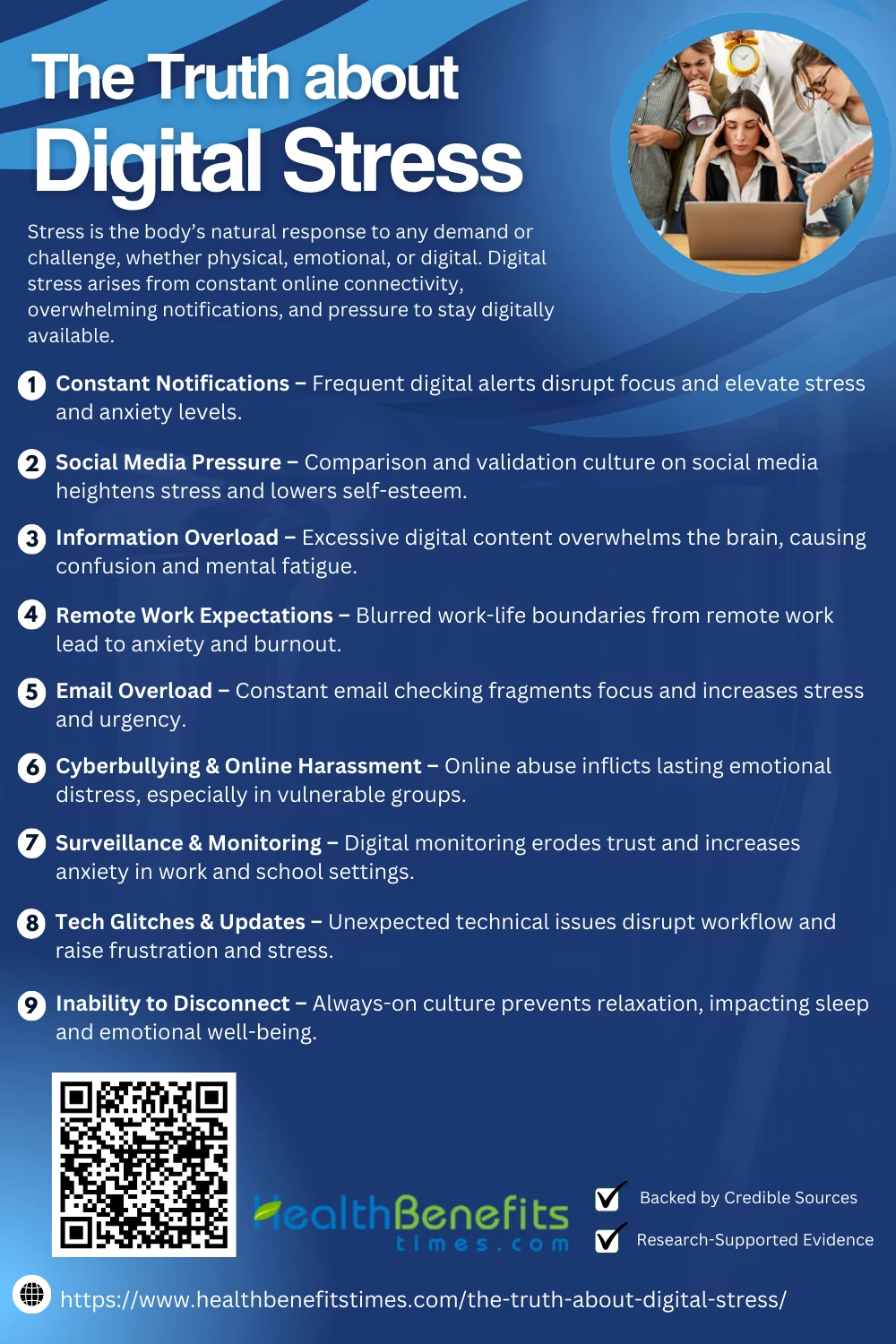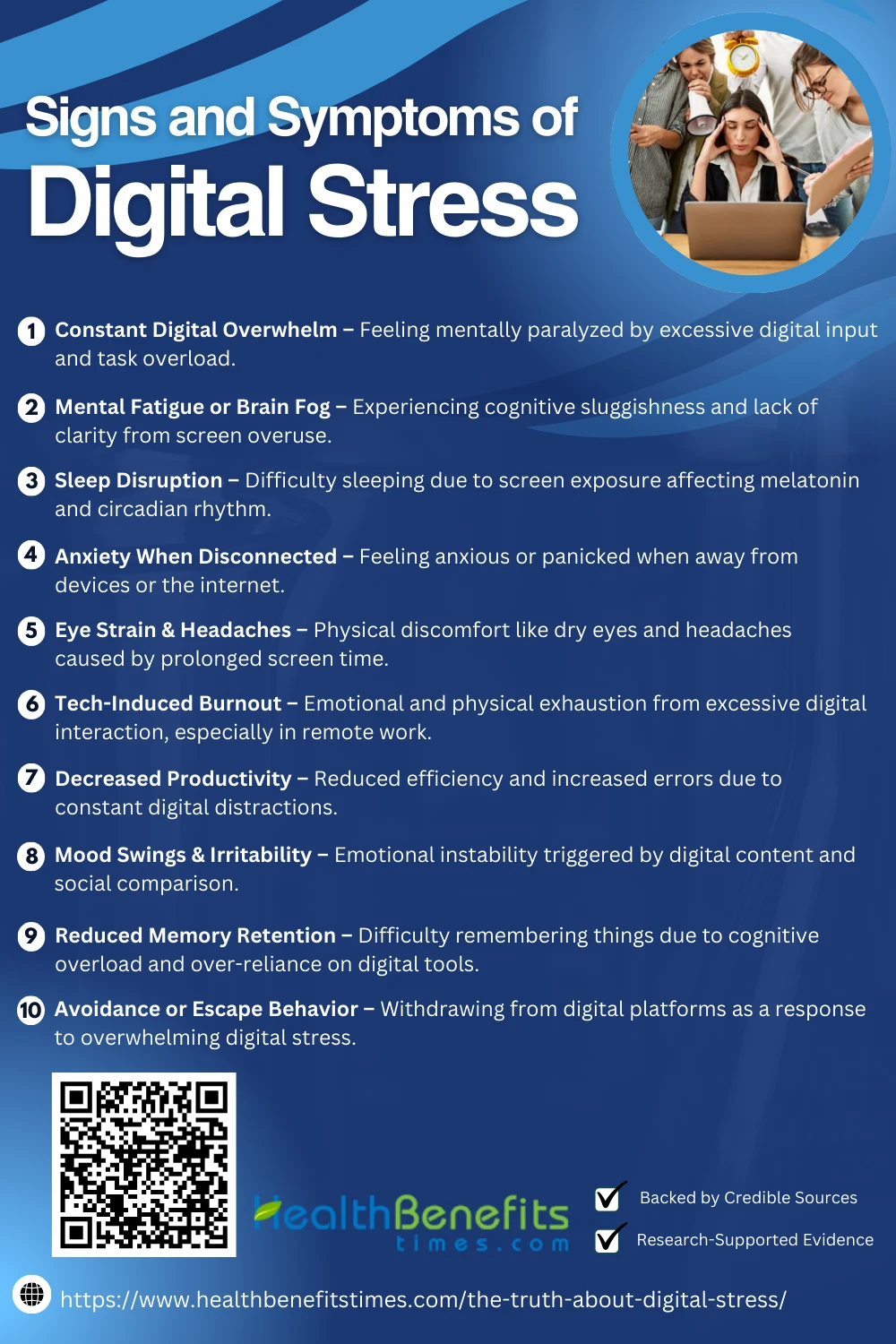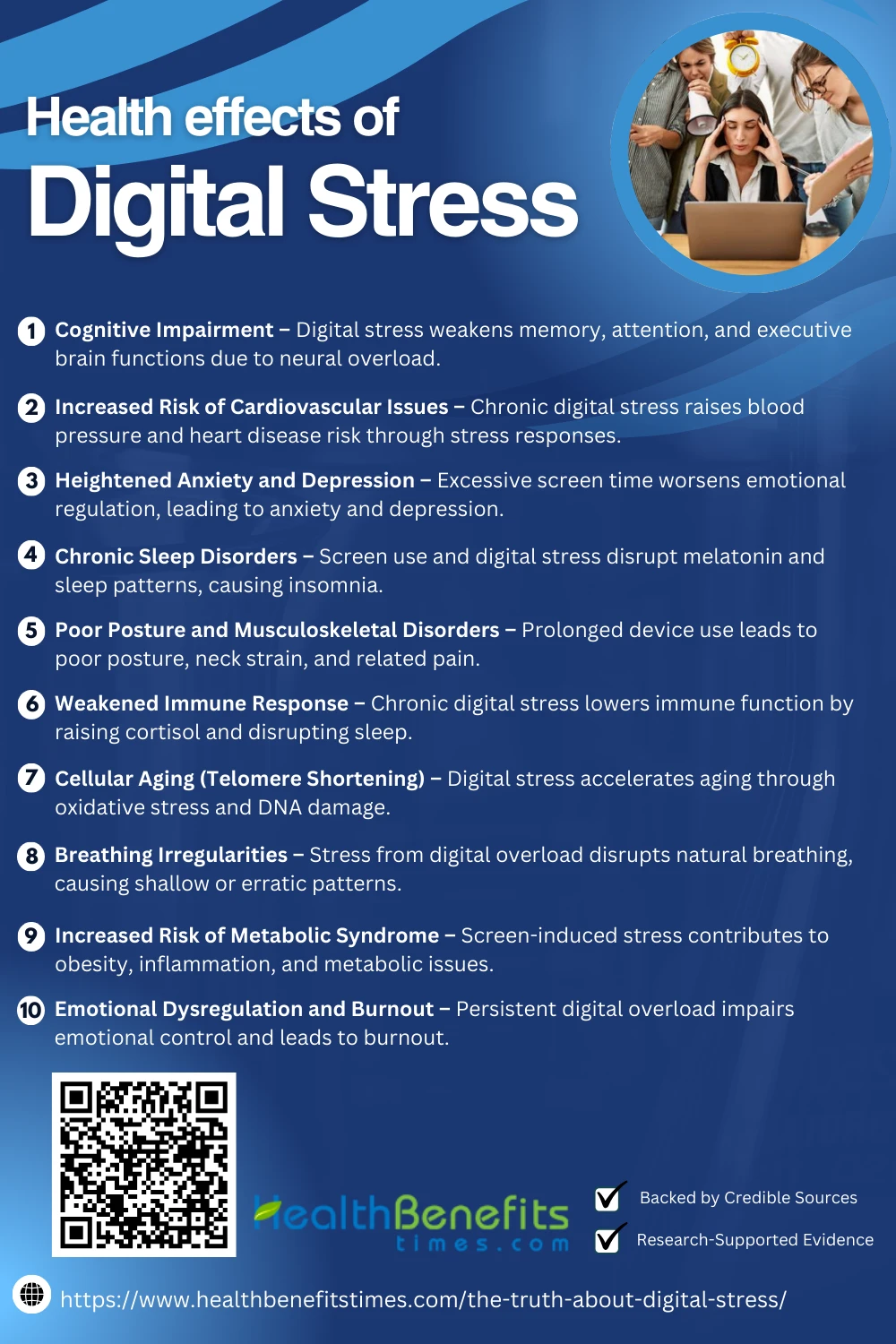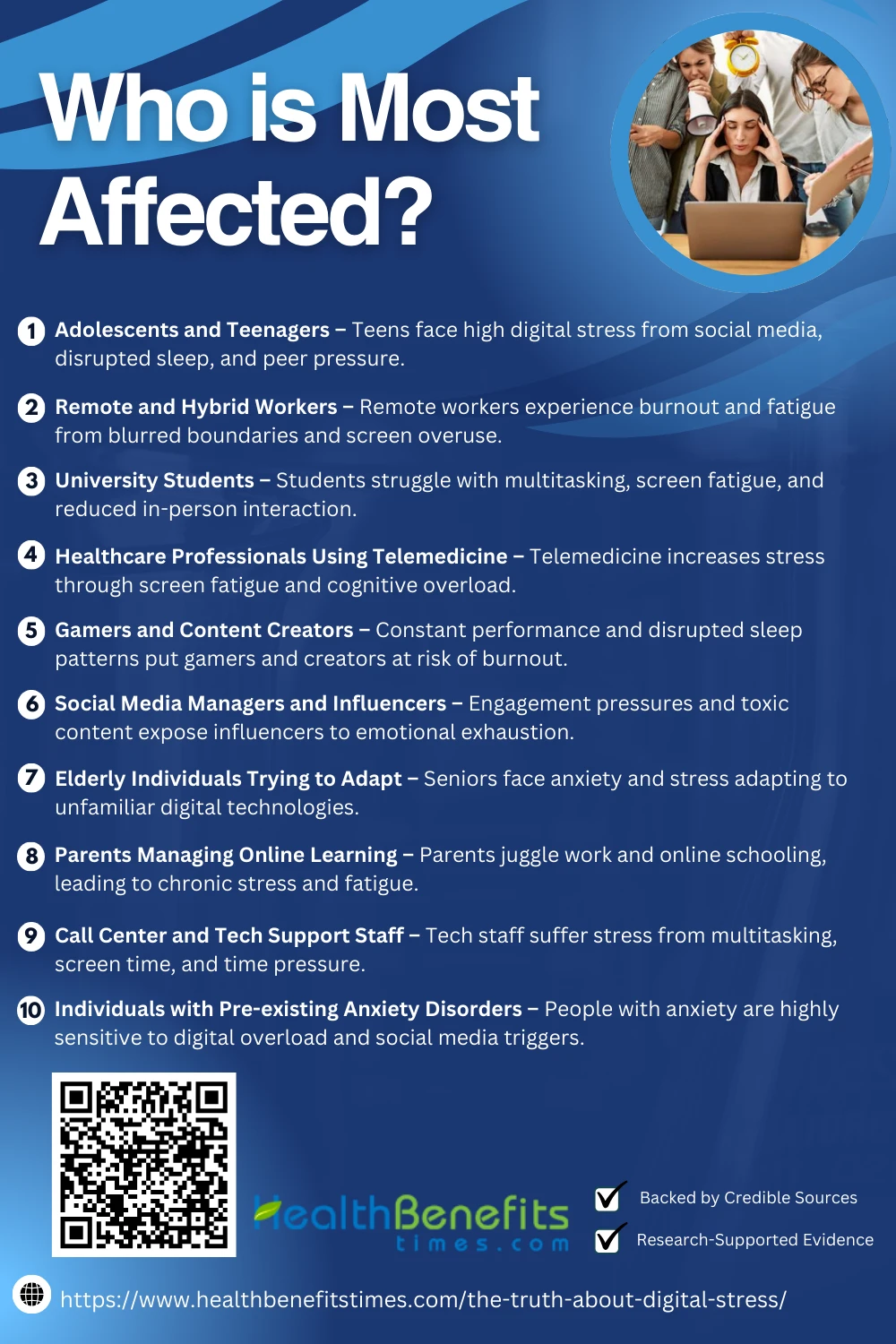- Stress is the body’s natural response to any demand or challenge, whether physical, emotional, or digital.
- Digital stress arises from constant online connectivity, overwhelming notifications, and pressure to stay digitally available.
- It can lead to anxiety, fatigue, sleep issues, and even long-term mental health challenges if not properly managed.
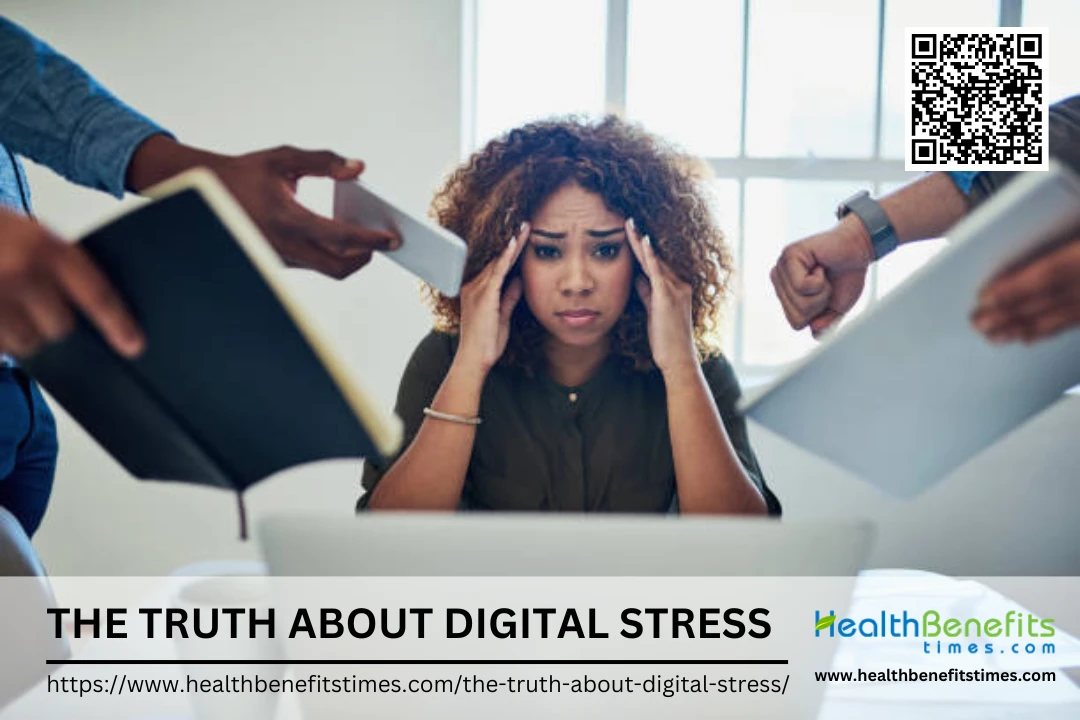 Stress is the body’s natural response to any demand that disrupts its equilibrium, especially when perceived demands exceed one’s coping abilities. In today’s hyper connected world, digital stress has emerged as a silent psychological burden tied to our reliance on technology. This form of stress stems from constant notifications, digital surveillance, and the need to remain perpetually available online. Studies show that excessive screen time and digital multitasking can impair emotional regulation and elevate cortisol levels, mimicking chronic stress responses. Moreover, the pressure to respond quickly to emails and social messages—often outside working hours—blurs boundaries between personal and professional life, contributing to burnout and emotional fatigue.
Stress is the body’s natural response to any demand that disrupts its equilibrium, especially when perceived demands exceed one’s coping abilities. In today’s hyper connected world, digital stress has emerged as a silent psychological burden tied to our reliance on technology. This form of stress stems from constant notifications, digital surveillance, and the need to remain perpetually available online. Studies show that excessive screen time and digital multitasking can impair emotional regulation and elevate cortisol levels, mimicking chronic stress responses. Moreover, the pressure to respond quickly to emails and social messages—often outside working hours—blurs boundaries between personal and professional life, contributing to burnout and emotional fatigue.
What Is Digital Stress?
Digital stress refers to the psychological strain individuals experience due to the overwhelming presence of digital devices and online demands. This form of stress often arises from persistent connectivity, social media pressure, work-related digital overload, and an expectation of immediate responsiveness. According to the American Psychological Association, digital stress includes experiences like anxiety from constant notifications, fear of missing out (FOMO), and cyberbullying. Research by Harvard Medical School links excessive digital engagement with higher cortisol levels, indicating a biological stress response. Moreover, workplace studies have shown that the “always-on” digital culture—such as emails after hours—contributes significantly to burnout and emotional fatigue. These sources underline how modern tech, while convenient, is silently fueling a unique kind of psychological stress.
How it differs from general stress
| Aspect | General Stress | Digital Stress |
| Definition | A physiological and psychological response to any perceived threat or pressure. | A subset of stress triggered by digital environments, devices, and online interactions. |
| Sources | Workload, financial issues, health problems, personal relationships, major life changes. | Notifications, screen time, social media pressure, digital surveillance, email overload. |
| Triggers | External events (e.g., job loss, conflict) or internal thoughts (e.g., worry, fear). | Overuse of devices, fear of missing out (FOMO), cyberbullying, and performance pressure from tech. |
| Duration | Can be acute (short-term) or chronic (long-term), depending on the situation. | Often chronic and cumulative due to constant digital exposure. |
| Physical Effects | Headaches, muscle tension, fatigue, sleep issues. | Eye strain, disrupted sleep (blue light), neck pain (“tech neck”), digital fatigue. |
| Mental Effects | Anxiety, irritability, mood swings, depression. | Digital burnout, social comparison anxiety, FOMO, attention fragmentation. |
| Management Approaches | Exercise, therapy, time management, mindfulness. | Digital detox, screen time limits, turning off notifications, digital mindfulness practices. |
Digital Stress vs. Digital Burnout
| Aspect | Digital Stress | Digital Burnout |
| Definition | A feeling of anxiety, tension, or overwhelm due to digital demands and connectivity. | A chronic condition of emotional, mental, and physical exhaustion caused by prolonged digital overuse. |
| Onset | Occurs in response to specific digital triggers (e.g., nonstop notifications, social media pressure). | Develops over time from sustained digital stress and lack of recovery. |
| Symptoms | Irritability, FOMO, distraction, tech anxiety, feeling overwhelmed. | Emotional numbness, fatigue, apathy, decreased motivation, cognitive fog. |
| Primary Cause | Acute exposure to digital environments (e.g., remote work stress, digital overload). | Chronic exposure without proper boundaries or rest (e.g., always-online culture). |
| Cognitive Impact | Difficulty focusing, over-checking devices, compulsive scrolling. | Decision fatigue, mental fog, inability to concentrate or care. |
| Emotional Response | Stress, anxiety, frustration. | Emotional detachment, hopelessness, emotional exhaustion. |
| Reversibility | Usually temporary and manageable with short-term strategies. | Requires sustained recovery efforts, possibly including therapy and long breaks. |
| Management | Digital boundaries, turning off notifications, mindful tech use. | Deep digital detox, extended rest, professional help, lifestyle restructuring. |
Causes of Digital Stress
Digital stress stems from constant connectivity, overwhelming notifications, social media pressure, and information overload. These digital demands can trigger anxiety, disrupt focus, and blur boundaries between work and personal life.
Constant digital notifications interrupt cognitive flow and contribute significantly to anxiety and attention fatigue. Studies have shown that frequent pings increase cortisol levels, triggering stress responses. (1) According to the American Psychological Association, these alerts often lead to compulsive device-checking. (2) Research also links notification overload with reduced productivity and emotional exhaustion (Frontiers in Psychology). (3) Even muted alerts can provoke stress due to anticipatory anxiety. (4)
2. Social Media Pressure
Social media fosters comparison culture, leading to low self-esteem, anxiety, and digital stress. Studies show that platforms like Instagram amplify feelings of inadequacy and FOMO. (2) Constant exposure to curated lives increases psychological distress. (5) Young users especially experience social validation pressure through likes and comments. Research also links excessive use with depression and sleep issues. (6) Even passive browsing is associated with increased stress responses. (7)
3. Information Overload
Digital environments flood users with information, overwhelming their ability to process and retain it. This cognitive overload leads to confusion, stress, and decision fatigue. (8) Research shows that constant content switching reduces focus and performance (Frontiers in Psychology). Notifications combined with information excess compound mental fatigue. (2) Social media, news apps, and emails contribute to this bombardment. (9) Chronic information exposure also impacts emotional regulation. (10)
4. Remote Work Expectations
Remote work often blurs boundaries between personal and professional life, increasing pressure to stay connected. Studies highlight that “always-on” expectations elevate anxiety and disrupt work-life balance. (11) Virtual meetings and excessive screen time contribute to Zoom fatigue. (12) Constant digital availability fosters emotional exhaustion (Frontiers in Psychology). This pressure erodes focus and increases burnout risk. (2) Even time zone mismatches amplify this stress. (13)
5. Email Overload
Email overload is a key driver of digital stress, especially in remote and hybrid workplaces. The average worker checks email 77 times daily, fragmenting focus and heightening task-switching fatigue. (14) Unread emails create a psychological burden and urgency bias. (2) Studies show that late-night email culture disrupts sleep cycles. (15) Constant inbox monitoring triggers anxiety (Frontiers in Psychology) and lowers job satisfaction. (16)
6. Cyberbullying & Online Harassment
Cyberbullying and online harassment create chronic emotional strain, especially among youth and marginalized groups. Victims often report anxiety, depression, and suicidal thoughts. (17) Exposure to online hate impacts self-esteem and social anxiety. (2) Even passive witnessing of harassment elevates distress (Frontiers in Psychology). Platforms often lack real-time protections, worsening vulnerability. Continuous exposure also impacts sleep and concentration. (18)
7. Surveillance & Monitoring
Digital surveillance in workplaces and schools fosters constant self-monitoring, reducing psychological safety. Employees tracked via software experience heightened anxiety and reduced autonomy (19) Surveillance increases performance pressure and stress responses. (20) In classrooms, students under surveillance tech feel less motivated and more distracted (Frontiers in Psychology). Constant data tracking can also trigger privacy fatigue and erode trust. (21) (2)
8. Tech Glitches & Updates
Frequent technical glitches and forced software updates are among the leading sources of digital stress. Studies show that disruptions caused by slow systems, sudden crashes, or incompatible updates significantly impair workflow and elevate anxiety levels. These issues can reduce productivity and contribute to frustration at work. (22) Moreover, users report heightened stress when updates interrupt ongoing tasks, and the unpredictability of glitches can erode confidence in digital tools. Therefore, minimizing system failures is essential to managing digital overload.
9. Inability to Disconnect
One of the most pervasive causes of digital stress is the inability to disconnect from devices. Constant connectivity blurs work-life boundaries, leading to digital fatigue and emotional exhaustion. (23) Research links persistent notifications to disrupted focus and increased cortisol levels. Workers feel pressure to stay “always on,” creating psychological strain. (24) Moreover, failure to unplug from work reduces sleep quality (Sleep Health Journal) and overall well-being.
Signs and Symptoms of Digital Stress
Signs of digital stress often appear subtly—persistent fatigue, anxiety, irritability, and difficulty concentrating. Physical symptoms like headaches and sleep issues may also arise, along with compulsive phone checking or social withdrawal.
This refers to the sensation of being mentally flooded by the sheer volume of digital input — emails, notifications, tabs, chats, and social media updates. People experiencing this may feel unable to prioritize tasks or even know where to start, leading to stress paralysis. It often manifests as a chaotic mental state where everything feels urgent and nothing gets completed.
2. Mental Fatigue or Brain Fog
After hours of interacting with screens, especially multitasking between apps or platforms, many people experience brain fog — a sluggish, unfocused state where thinking clearly becomes difficult. This isn’t just tiredness; it’s a cognitive overload that drains mental energy, making even simple decisions feel taxing.
3. Sleep Disruption
Digital devices emit blue light, which suppresses melatonin, the hormone that regulates sleep. Exposure to screens—especially close to bedtime—can throw off your circadian rhythm. People with digital stress may struggle to fall asleep, stay asleep, or feel rested even after sleeping, leading to chronic sleep deprivation over time.
4. Anxiety When Disconnected
Known as nomophobia (no-mobile-phone phobia), this is the fear or anxiety that arises when a person is without their device or can’t access the internet. It’s marked by compulsive checking, fear of missing out (FOMO), and even panic attacks when Wi-Fi is lost or the battery runs low. It reveals a deep emotional dependency on digital connectivity.
5. Eye Strain & Headaches
Extended screen use can cause physical symptoms collectively known as Computer Vision Syndrome. These include dry eyes, blurred vision, double vision, and tension headaches. These symptoms result from poor lighting, screen glare, improper viewing distances, and unbroken focus on the screen without blinking.
6. Tech-Induced Burnout
Digital burnout is a state of emotional, physical, and mental exhaustion caused by prolonged tech use. It’s particularly common in remote work or “Zoom fatigue” scenarios where individuals hop from one virtual meeting to another without a break. Burnout reduces motivation and productivity and can lead to long-term disengagement.
7. Decreased Productivity
Digital overload may seem like being busy, but it’s often counterproductive. Notifications, multitasking, and app-switching create constant interruptions that break flow and increase cognitive load. Over time, this can cause people to make more mistakes, forget things, and feel that they are always behind, even after long hours of work.
8. Mood Swings & Irritability
Social media and digital platforms often expose individuals to negative content, polarizing opinions, or unrealistic portrayals of others’ lives. Constant comparison or exposure to negativity can destabilize emotions. People experiencing digital stress may feel easily frustrated, moody, or emotionally reactive in everyday interactions.
9. Reduced Memory Retention
Digital stress affects how we encode and store memories. When overwhelmed, the brain has a harder time transferring short-term information into long-term memory. Add to this the tendency to “Google everything,” and people may find their ability to remember things without looking them up significantly diminished.
10. Avoidance or Escape Behavior
As a coping mechanism, some individuals start withdrawing from digital platforms altogether. They may ignore emails, stop responding to messages, or even delete apps. While breaks are healthy, avoidance stemming from burnout reflects deeper distress and may lead to professional or social disconnects.
Health effects of digital stress
Digital stress can harm your health by increasing anxiety, disrupting sleep, and weakening immunity. It may also contribute to headaches, eye strain, and long-term issues like burnout or depression.
Digital stress is increasingly linked to cognitive impairment, especially memory dysfunction and attention deficits. Studies have shown that continuous exposure to digital overload disrupts neural connectivity in the prefrontal cortex digital multitasking effects, impairs executive function working memory decline, and heightens cortisol levels that compromise hippocampal activity chronic stress study. Prolonged screen exposure also induces fatigue-related neural inefficiency cognitive fatigue, while excessive online interactions have been shown to deteriorate cognitive empathy social cognition impairment.
2. Increased Risk of Cardiovascular Issues
Digital stress triggers physiological responses akin to chronic stress, significantly elevating the risk of cardiovascular issues. High engagement with digital devices raises heart rate variability and blood pressure HRV disruption. Sleep disruption due to screen time further compounds cardiac strain sleep and heart health. Psychological stress from online environments is linked to increased sympathetic nervous activity SNS overactivation, which contributes to arterial stiffness arterial health. Over time, these mechanisms contribute to hypertension and coronary artery disease cardiac impact study.
3. Heightened Anxiety and Depression
Prolonged digital stress has been strongly linked to elevated levels of anxiety and depression, especially in adolescents and working professionals. Excessive screen time interferes with emotional regulation and contributes to mood dysregulation study on emotional health. Constant online connectivity amplifies social comparison and FOMO, key predictors of depression social media depression. Chronic digital exposure increases stress hormone levels, correlating with anxiety disorders cortisol and anxiety. Moreover, digital overload disrupts dopamine pathways, affecting emotional stability dopaminergic disruption and may even alter amygdala function brain imaging research.
4. Chronic Sleep Disorders
Digital stress significantly contributes to chronic sleep disorders by interfering with melatonin production and circadian rhythms blue light and sleep. The overuse of digital devices at night prolongs sleep latency and reduces sleep quality screen time sleep latency. Digital-induced stress increases nighttime rumination, delaying deep sleep onset rumination effect. Notifications and late-night engagement fragment sleep architecture sleep fragmentation from devices, while persistent exposure to stress from digital overload is associated with long-term insomnia symptoms insomnia research.
5. Poor Posture and Musculoskeletal Disorders
Digital stress contributes to poor posture and musculoskeletal disorders, especially among individuals who sit for extended periods using screens. Sustained digital device use leads to forward head posture and spinal strain postural strain study. Repetitive strain from mobile texting and keyboard use exacerbates neck and shoulder pain tech neck research. Studies link screen-time fatigue to decreased core muscle engagement ergonomics findings. Long hours of digital interaction are also associated with carpal tunnel symptoms keyboard-induced disorder and low back pain lumbar impact research.
6. Weakened Immune Response
Chronic digital stress may suppress immune function by activating the hypothalamic-pituitary-adrenal (HPA) axis, resulting in elevated cortisol levels stress immunity study. Prolonged screen exposure and online overload can disrupt sleep, reducing immune cell production sleep-immunity link. Digital fatigue is also associated with increased inflammation markers inflammatory response research. Social media-induced anxiety further impairs immunoregulation psychoneuroimmunology article, and screen time can diminish natural killer (NK) cell activity, crucial for fighting infections immune suppression study.
7. Cellular Aging (Telomere Shortening)
Digital stress accelerates cellular aging through increased oxidative stress and telomere shortening oxidative stress link. Constant online stimulation elevates cortisol, which is associated with DNA damage cortisol and aging. Blue light exposure from devices contributes to mitochondrial dysfunction and premature aging blue light impact. Studies show that psychological digital stress can alter gene expression related to cell longevity epigenetic study. Additionally, digital overload impairs autophagy, reducing the body’s ability to remove aging cells autophagy and stress.
8. Breathing Irregularities
Digital stress disrupts natural breathing patterns, often leading to shallow or irregular respiration breathing pattern study. Anxiety triggered by digital overload activates the sympathetic nervous system, promoting hyperventilation SNS and breathing. Continuous screen engagement reduces diaphragmatic breathing efficiency posture-breath link. Moreover, emotional reactivity from online interactions can provoke sighing and erratic breath cycles affective respiration research. Over time, these changes contribute to chronic respiratory dysregulation respiratory health impact.
9. Increased Risk of Metabolic Syndrome
Digital stress is linked to increased risk of metabolic syndrome, primarily through elevated cortisol and disrupted glucose metabolism stress and insulin resistance. Excessive screen time reduces physical activity, contributing to central obesity and hypertension sedentary behavior link. Studies show digital stress increases inflammatory cytokines, a key factor in metabolic disorders inflammatory response study. Chronic exposure to digital overload is associated with abnormal lipid profiles lipid dysregulation research, while poor sleep quality from screen overuse exacerbates metabolic risk sleep-metabolism study.
10. Emotional Dysregulation and Burnout
Digital stress significantly contributes to emotional dysregulation by overloading the brain’s prefrontal cortex executive dysfunction study. Constant exposure to online negativity and multitasking impairs emotional control mechanisms digital overload effects. Research shows persistent digital engagement reduces resilience and coping abilities, increasing emotional volatility coping deficit research. Burnout, especially in digital work environments, is tied to chronic overstimulation and lack of recovery burnout and screen fatigue. Furthermore, tech-related stress alters amygdala activation, intensifying emotional reactivity neurocognitive effects.
Who is Most Affected?
Digital stress affects nearly everyone, but teens, remote workers, and heavy social media users are most vulnerable. Constant online demands and screen exposure make these groups especially prone to mental fatigue.
Adolescents face heightened digital stress due to excessive social media exposure, leading to anxiety and depression social media mental health. Studies show screen overuse disrupts sleep cycles screen time and sleep, while digital peer pressure contributes to emotional dysregulation peer influence effects, making youth a high-risk group for psychological impacts.
2. Remote and Hybrid Workers
Remote and hybrid workers suffer from digital stress driven by blurred work-life boundaries remote burnout study, constant notifications digital overload research, and extended screen time ergonomic strain study. These factors contribute to burnout, musculoskeletal discomfort, and emotional fatigue, severely affecting their productivity and long-term mental well-being.
3. University Students
University students experience intense digital stress from academic multitasking, excessive screen exposure, and reduced offline interaction student stress study. Online learning platforms contribute to attention fatigue e-learning fatigue, while poor ergonomics and mental overload exacerbate anxiety and depression levels in this demographic digital academic burnout.
4. Healthcare Professionals Using Telemedicine
Telemedicine professionals face high digital stress due to extended screen use, clinical decision fatigue, and reduced interpersonal interaction telehealth stress impact. Constant patient management through digital interfaces induces cognitive overload cognitive fatigue in clinicians, while inadequate tech support heightens anxiety and burnout risks digital burnout in healthcare.
5. Gamers and Content Creators
Gamers and content creators experience digital stress from performance pressure, disrupted circadian rhythms gaming and sleep disruption, and continuous engagement with online audiences streaming burnout. Studies link prolonged gaming with elevated stress hormones and reduced emotional regulation gaming and cortisol, placing them at higher risk for mental fatigue and burnout.
6. Social Media Managers and Influencers
Social media professionals endure digital stress due to algorithmic unpredictability algorithm stress impact, constant connectivity social media fatigue, and performance-based self-worth influencer mental health study. This group faces anxiety from engagement metrics, content deadlines, and exposure to online toxicity, making them vulnerable to emotional exhaustion and identity strain.
7. Elderly Individuals Trying to Adapt
Elderly individuals struggle with digital stress due to unfamiliarity with technology, reduced cognitive flexibility tech literacy in older adults, and limited support systems digital divide and seniors. Studies show that adapting to digital tools increases anxiety and can negatively impact mental health and confidence elderly tech anxiety.
8. Parents Managing Online Learning
Parents face digital stress while managing online learning, balancing work-from-home pressures and children’s education parental burnout pandemic. Inadequate tech resources and constant supervision needs cause chronic fatigue online learning strain. Studies link digital overload with higher parental anxiety and reduced emotional availability for children parent stress and screen time.
9. Call Center and Tech Support Staff
Call center and tech support staff experience high digital stress from constant multitasking, high cognitive demand multitasking strain study, and repetitive digital workflows tech fatigue research. Studies indicate that limited autonomy, extended screen exposure, and time pressure lead to emotional exhaustion and musculoskeletal strain call center burnout study.
10. Individuals with Pre-existing Anxiety Disorders
Those with anxiety disorders are especially vulnerable to digital stress due to hyper-responsiveness to online stimuli digital triggers and anxiety. Excessive screen time exacerbates rumination and emotional instability screen use and anxiety, while social media exposure amplifies threat perception and comparison-based distress social anxiety amplification.
How to Manage and Reduce Digital Stress
Managing digital stress starts with setting healthy boundaries—limit screen time, mute non-essential notifications, and take regular breaks. Incorporate mindfulness, physical activity, and prioritize offline connections to restore mental balance.
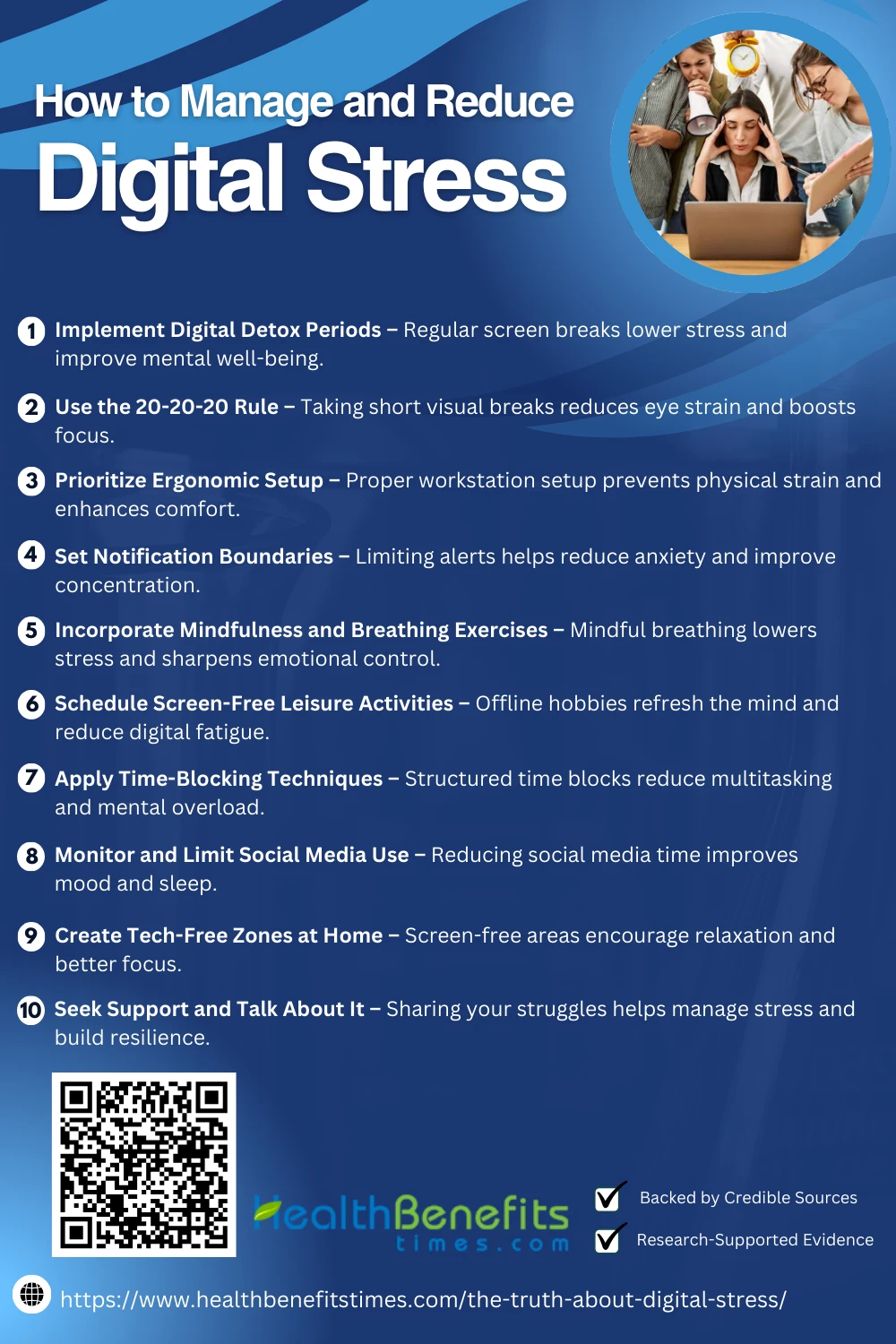 1. Implement Digital Detox Periods
1. Implement Digital Detox Periods
Digital detox periods help restore cognitive balance and reduce stress hormones digital detox study. Research shows that intentional screen breaks improve sleep quality screen time and sleep and enhance emotional well-being by lowering anxiety levels detox and mental health. Regular unplugging fosters healthier boundaries with technology.
2. Use the 20-20-20 Rule
The 20-20-20 rule reduces eye strain and digital fatigue by encouraging visual breaks visual ergonomics study. Evidence supports that short breaks improve focus and productivity cognitive recovery research. It also helps prevent digital eye strain symptoms such as dryness, headaches, and blurred vision screen use eye health.
3. Prioritize Ergonomic Setup
Optimizing your workstation reduces physical strain and prevents musculoskeletal disorders ergonomic intervention study. Research shows that proper screen height, chair support, and posture improve comfort and productivity office ergonomics research. Ergonomic alignment also helps reduce digital fatigue and tension-related headaches visual and posture-related stress.
4. Set Notification Boundaries
Managing notifications significantly lowers cognitive load and anxiety digital distraction study. Studies show constant alerts impair focus and increase stress responses notification overload research. Creating structured “notification-free” intervals improves mental clarity, emotional regulation, and reduces overall digital burnout attention restoration theory.
5. Incorporate Mindfulness and Breathing Exercises
Mindfulness and breathing techniques reduce digital stress by activating the parasympathetic nervous system mindfulness and stress regulation. Research supports their role in lowering cortisol levels and improving emotional regulation breathing and anxiety study. These practices also enhance attention span, making them effective for managing screen-related mental fatigue digital mindfulness benefits.
6. Schedule Screen-Free Leisure Activities
Engaging in screen-free leisure activities like nature walks or art helps reset cognitive load nature and attention restoration. Studies show that digital breaks improve mood and reduce stress hormones leisure and stress reduction. Such activities also enhance creativity and social connection, essential for overall digital well-being offline recovery research.
7. Apply Time-Blocking Techniques
Time-blocking enhances productivity by structuring digital tasks into focused intervals time-blocking productivity study. Research shows it reduces multitasking fatigue and cognitive overload task-switching and stress. Incorporating breaks between blocks allows the brain to reset, improving focus and minimizing burnout associated with prolonged screen exposure mental recovery benefits.
8. Monitor and Limit Social Media Use
Limiting social media reduces anxiety, improves mood, and supports healthier sleep patterns social media and mental health. Studies show that excessive scrolling contributes to digital fatigue and fear of missing out (FOMO) FOMO and stress link. Mindful usage tracking fosters better emotional regulation and digital well-being usage monitoring effectiveness.
9. Create Tech-Free Zones at Home
Designating tech-free zones promotes healthier sleep, reduces cognitive overload, and improves interpersonal connection bedroom tech exclusion study. Research links screen-free spaces to lower stress levels and better mental focus environmental stress management. These areas encourage mindfulness and relaxation, helping offset the effects of continuous digital stimulation digital boundaries research.
10. Seek Support and Talk About It
Talking about digital stress with peers or professionals alleviates emotional burden and promotes resilience psychosocial support research. Studies show that verbalizing stress enhances coping strategies and reduces anxiety peer support and mental health. Group or therapeutic support also builds awareness and self-regulation skills essential for digital balance therapy and digital burnout.
When to Seek Help
Seeking help for digital stress is essential when symptoms persistently interfere with daily life. Warning signs include chronic fatigue, disrupted sleep digital stress and insomnia, emotional dysregulation affective overload study, physical pain from device overuse tech-induced musculoskeletal stress, and heightened anxiety or depressive symptoms digital mental health link. Professional support becomes crucial when self-regulation strategies fail psychological intervention effectiveness, as early intervention can prevent long-term cognitive, emotional, and physical deterioration.
Conclusion
Digital stress is a growing concern in our always-connected world, silently impacting mental, emotional, and physical well-being. From constant notifications to the pressure of being available 24/7, our digital habits can take a serious toll. Recognizing the signs and understanding the causes is the first step toward regaining control. By setting boundaries, taking regular breaks, and practicing mindfulness, you can reduce digital stress and restore balance in your life. Remember, technology should serve you—not overwhelm you. Take time to unplug, reconnect with the present, and prioritize your health. The truth is, a healthier digital life starts with mindful choices.


